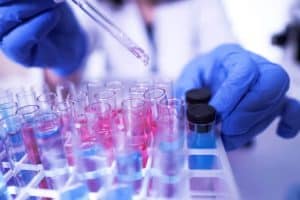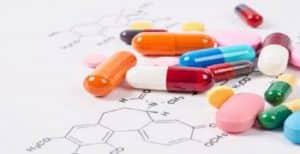The subject of Pharmaceutical Chemistry or medicinal chemistry involves the design and manufacture of compounds that can prevent or treat diseases in humans or animals. This science includes the study of existing drugs, the study of their biological properties, and the relationships between their activity structures.
IOPAC’s definition of Pharmaceutical Chemistry is (the discovery, development, identification, and interpretation of the function of biologically active molecules at the molecular level). Pharmaceutical Chemistry covers the following steps:
- In the first stage, new active compounds or drugs are identified and prepared through natural sources, organic chemical reactions, or biotechnological processes.
- The next step involves optimizing the structure of the molecules to improve their ability, selectivity, and reduce their toxicity.
- The third stage also includes the optimization of large-scale synthetic methods and the modification of the medicinal properties of active compounds for clinical use.
Medicinal chemistry means the application of chemical research techniques to the synthesis of medicinal substances. In the early stages of the development of medicinal chemistry, chemists were mainly involved in the separation of medicinal compounds in plants. Scientists today are just as involved in creating new synthetic compounds as drugs. Medicinal chemistry almost always relies on the discovery and development of drugs.
The focus on the development of new synthetic drugs has led to the involvement of other disciplines such as biochemistry and molecular biology. Most researchers work with a team of biologists, toxicologists, pharmacologists, theoretical chemists, microbiologists, and more. Such collaboration enables the clever use of analytical techniques to synthesis new drugs and develops the most cost-effective tools for their production.

Based on the above concepts, it can be summarized that medicinal chemistry is a range of pharmaceutical sciences that uses the principles of chemistry and biology to create knowledge that can lead to the introduction of new drugs.
The first drugs were of natural origin and were mainly extracted from plants and used to treat infectious diseases. Centuries ago, the Chinese, Indians, and peoples of the Mediterranean region were familiar with the healing uses of some plants and minerals. For example, the plant Changshan was used to treat malaria in China.
Fundamental aspects of medicines:
The World Health Organization (WHO) defines medicine as (any substance used in pharmaceutical processes that causes the discovery or modification of physiological processes or disease states in order to improve the consumer) and Introduces pharmaceutical products as a form of medicine that contains one or more drugs along with other substances that are added in the manufacturing process.
The naming of drugs:
The chemical name of a drug is a name that unambiguously describes the chemical structure of a drug and introduces it accurately and completely, and is named according to the rules for naming chemical compounds.

- Each drug has three or more names, which are:
- Password number or password of choice
- Chemical name
- Non-scientific proprietary name (commercial)
- Non-proprietary generic name
- Synonyms
Classification of drugs:
Drugs are classified according to a variety of criteria, including:
- Chemical Building;
- Pharmacological effect;
- Therapeutic uses;
- Chemotherapy building, descriptive;
- Mechanism of action at the cell surface.
Use of drugs:
Medications are used for specific purposes, which are:
-Provide the body with essential nutrients, such as vitamins
-Prevention of infections, such as therapeutic serums and vaccines
-Detoxification, such as antidotes
-Temporary inhibition of a normal function, such as anesthetics
-Correcting actions that have been disrupted and …
Types of drugs based on their biological effects:
Analgesics:
Analgesics are used to relieve a variety of pain, which can be mild, moderate, or severe. Examples of these drugs include codeine phosphate, tramadol, morphine, and fentanyl.
Antipsychotics:
Antipsychotic drugs are mainly prescribed by a psychiatrist to reduce the symptoms of psychosis and are also used to treat mental disorders. Examples of these drugs: Chlorpromazine, phenophenazine, thioridazine, haloperidol, etc
Antihypertensive drugs:
A wide range of medications are available to lower blood pressure, including the following: Diuretics (diuretics), thiazides, chlorthalidone, Salmeterol, Beclomethasone, Aminophylline
Antiseptic:
This group of substances is used on the surface of living tissues of the skin and body and by killing bacteria or viruses, fungi, spores of bacteria, and other organisms, they kill them or prevent their growth. This group of substances is basically separate from antibiotics and disinfectants because antibiotics kill bacteria safely inside the body. Examples of these drugs include Glutaraldehyde, Isopropyl alcohol, Hydrogen Peroxide.
Antibiotics:
Antibiotics are an important class of drugs that fight bacterial infections in the body, or kill bacteria, or prevent them from growing and multiplying in the body. Including these drugs: Penicillin, Streptomycin, Amoxicillin, Clindamycin

Antimicrobial:
An antimicrobial is a compound that kills or stops microorganisms from growing. Antimicrobials are classified according to the type of microorganism they work against. Examples of these drugs: Sulfacetamide, Benzoyl Peroxide.
A further point is that many drugs do not fit purely into one category or another and some drugs may have more uses than just one. For example, a sedative might also have been used as an anticonvulsant.
There are drugs that have special effects on the body but do not cure a specific disease. Examples of these drugs are morphine (analgesic), cocaine (anesthetic), atropine (anticonvulsant), etc. The use of these drugs may help cure a microbial or viral infectious disease.
Therefore, medicinal chemistry is a branch of chemistry in which different chemicals are used for treatment. The compounds used in medicines are often organic and fall into the category of organic materials, so this science deals mainly with small organic compounds. By making the necessary changes, they prepare them for therapeutic use. In medicinal chemistry, drugs are identified, synthesized, and studied, and the main activity of specialists is in laboratories, which are a good place to produce drugs and conduct research on them. In this science, appropriate methods of treatment for various diseases are found and in some of its sub-branches, including drug metabolism, pharmacokinetics, and pharmacodynamics, research is done on the effects of drugs.






